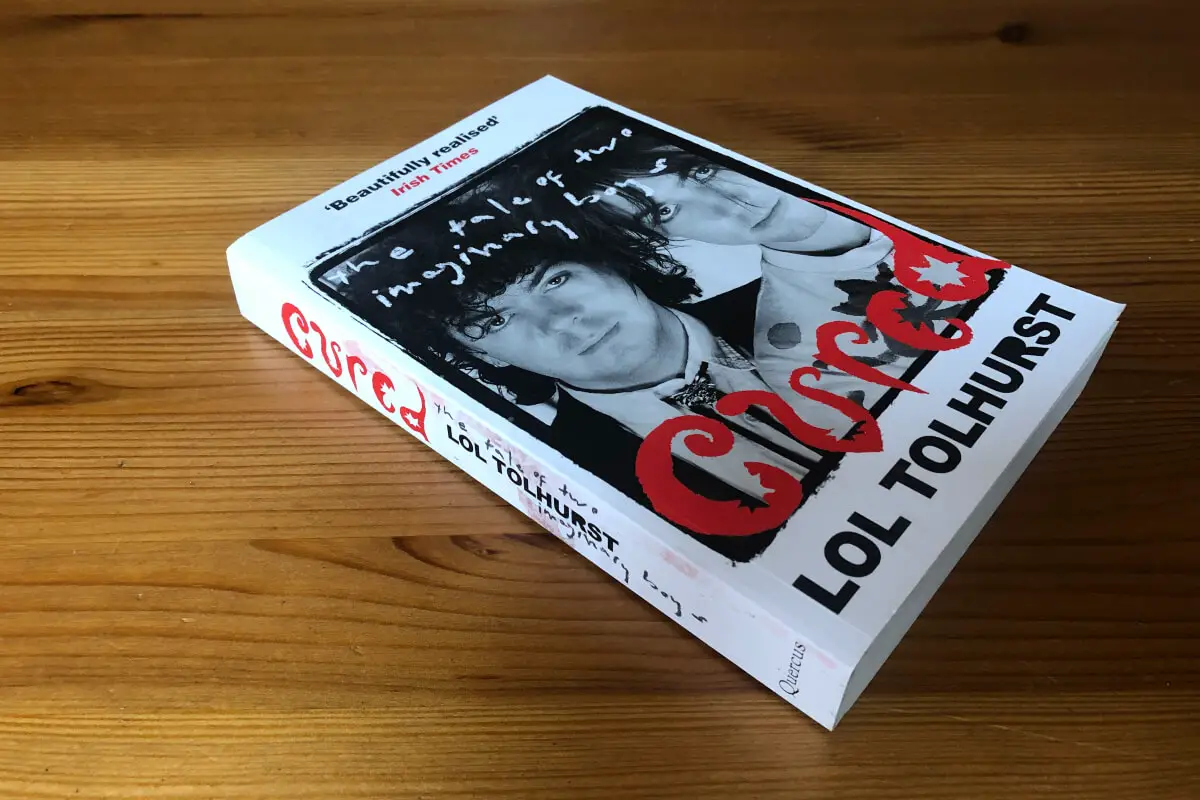Cured: The Tale Of Two Imaginary Boys

I’m a huge fan of The Cure, having been converted after seeing them perform at Reading Festival in 2012, and then later Wembley (on my own no less!) in 2016. Watching their Glastonbury set on TV last year from the comfort of my own sofa is something I’ll always remember, and I wasn’t even there in person!
As a result, I have long been on the look out for a first-hand account of the band’s humble beginnings in Horley / Crawley, half way between London and Brighton, and just up the road from my own hometown. Horley is where my own Mother grew up – in fact, the band used to practice at the Church she attended, and I still have family in both towns. So it was only natural that I should want to learn more about a band I much admire, and that also started out from a part of the world I know very well.
I’m not sure I’d realised that Cured was an autobiography (or “memoir”) by drummer and later keyboardist Lol Tolhurst when I first purchased it, but this turned out to be a pleasant surprise. Tolhurst was one of the band’s founding members and though no longer a part of The Cure, he remains an important part of their history. Whilst not the band’s most well-known member obviously (The Cure will always be Robert Smith’s band for many), he was close enough to the action – at least during the band’s first decade and a bit – to be able to recount every little detail, whilst being able to do so from a sense of perspective, as a result of not having been on the frontline with Robert. It reminded me a lot of Peter Hook’s – Joy Division’s bassist – Inside Pleasures in that regard, with both authors acknowledging that their respective bands’ identity was an extension of their enigmatic frontmen to at least some extent.
View this post on Instagram
I very much enjoyed reading about Lol and his bandmates’ early years. The Cure’s band members have pretty much always been drawn from a small cluster of close childhood friends, with Robert and Lol starting out playing alongside the likes of Michael Dempsey and Porl Thompson, local lads whose own musical histories are intertwined with the band. As a result, Lol’s childhood memories don’t just cover his own formative years but the band’s in general. Mentions of locations I know provided me with a real sense of pleasure, for example the industrial estate in my hometown East Grinstead where Lol and his bandmates worked for a defence contractor that made missile parts. Crawley on the other hand draws a lot of ire from the author, who describes the new town as a “suburban swamp” – a place with no future and little hope. A little harsh perhaps, even if some of those in East Grinstead – Crawley’s smaller but more desirable neighbour – might agree!
Whilst his characterisation may still ring true to some, Lol and his friends were coming of age during a dark period in England’s recent history, characterised by an ailing economy, skyrocketing unemployment and the rationing of electricity. He points out that many local people but particularly the youth were bored and felt like they were treading water. A perfect storm of protest and discontent had already given rise to punk music in London, and Crawley was close enough to the capital that escape seemed possible should Lol et al. embrace this new movement. So whilst few would associate The Cure with punk music, the band clearly remain proud of the fact that they were the first punks in Crawley!
In terms of their sound however, Lol makes the point that any post-punk influences on the band were absorbed gradually, with Robert making slow, deliberate decisions about the band’s identity and musical direction. But when you think about it, there was little music on TV at the time, no internet, and no local bands in a town like Crawley to show The Cure the way. Is it any wonder that they forged such a unique sound and legacy?
In fact, one of the biggest influences on the band according to Lol, was the time they spent at Notre Dame school in the throes of the Surrey countryside. Lol describes it in glowing terms but when I was of school age it was the subject of much ridicule – a place where all the posh drama types went! As they began to spread their wings further afield, it was Siouxsie Sioux and Steven Severin that took The Cure under their wings – based on Lol’s description of their help, I could have done with my own Siouxsie and Severin to teach me to more forcefully assert my opinions when starting out in the music industry, as like the polite, middle-class boys in The Cure, I was never particularly insistent about my own wants and needs until I left the music business. Like the band, I chose a very English way of dealing with my emotions, by not dealing with them at all, with similarly spectacular and in hindsight, predictable results!
Maybe because I’m not a die-hard fan, but it feels to me like the book affords appropriate weight to each period of The Cure’s early years. Less attention is bestowed upon Lol’s later years in the band but it seems that much of that can be attributed to his drinking problem, which caused him to become increasingly isolated from his old friend Robert and the rest of the band. No longer able to contribute creatively as a result of his addiction to drink, a final show at Wembley in December 1987 would mark his last gig with The Cure for nearly a quarter of a century.
Sadly, it would take Lol a while to finally acknowledge his problem and seek proper treatment for it. A much-publicised legal fight over royalties between Lol and the band would follow before he would finally see things for what they were, and whilst he does put forward a damning indictment of the legal system operating around the music industry (at least at the time), he’s also strikingly honest and upfront about the fact that he was mostly using the case as a means to strike out at those around him, rather than look inwards for the answers to those things that were still troubling him.
Fortunately, whilst Lol’s life had turned very grey as a result of his alcoholism, the fog would eventually lift following a move to the US, where he reconnected with nature and broke the chain of family dysfunction by learning to be a true father to his son. Later, he would rediscover his confidence in his abilities as a creative musician, freed from the burden of addiction and emboldened by his restored friendship with Robert, who he had written to in 2000 in an attempt to right the wrongs he’d done previously. A detailed retelling of an emotional reunion backstage at a Cure gig many months later is the book’s most poignant moment, with Robert interrupting Lol’s admission of guilt mid-flow by placing his hand upon his old pal’s shoulder, forgiving him in an instant.
Speaking of Robert, this may not be his book but unsurprisingly the iconic frontman features heavily. Lol’s portrayal of his friend’s human side is really heartwarming, providing a glimpse into the life of the man behind the genius. Interestingly, Lol says that Robert has always been someone that has been “on intimate terms” with the same abyss that Ian Curtis and Kurt Cobain looked out over. He believes that Robert tried to fight this by putting his guitar between him and his demons. But as a frontman, he could no longer hide from them, and his embrace of these forces was ultimately what allowed him to not only survive but prosper.
Overall then, I can only speak about Cured: The Tale Of Two Imaginary Boys in glowing terms. It’s a wonderful read, which will endear the band to anyone who decides to pick it up. Possibly the only disappointment to this read was the accompanying pictures, which have been badly presented, and would have benefitted from having been printed on glossed or laminated paper.
Even that though fails to detract from this stellar companion to The Cure. One of the biggest compliments I can pay it is that I usually refer to the author by their surname when writing these reviews. However, in the case of Cured, referring to Lol by anything other than his first name (or at least, its abbreviation from Laurence) would have felt far too informal, such was the sense of intimacy I felt that I now shared with him after reading this memoir. It’s an absolute triumph from start to finish – a fantastic retelling of the story of one of the quintessential British bands, from someone who endured all the significant ups and downs.

